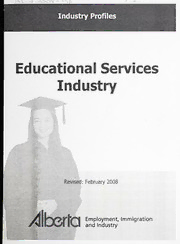
Industry profiles PDF
Preview Industry profiles
Educational Services Industry February 2008 Employment, Immigration and Industry Digitized by the Internet Archive in 2017 with funding from University of Alberta Libraries https://archive.org/details/industryprofile2008albe_3 1 Overview: The Educational Services industry1 in Albertaincludes: public andprivate schools, colleges, universities and trainingcentres; instructional and training services; and related support services such as food and accommodation for students. SectionA: Business Environm ^ 1. Employmentand UnemploymentNumbers and Rates 2. Industry Growth 3. Company Size Human SectionB: 1. Occupational Information 2. Demographics: Age and Gender 3. Wages Section C: AdditionalInformation 1. links to Industry Associations 2. Links to Government LibraryDatabase 1 NorthAmericanIndustryClassificationSystem (NAICS)majorgroup61 Data DevelopmentandEvaluation 2 SectionA: Business Environment 1. 2006Employment andUnemploymentNumbers and Rates: Educational Services '• Alberta ' .. Industry Number ofemployed 1,870,700 130,400 Percentemployed in the 7.0% industry Number ofunemployed 66,800 3,500 Unemploymentrate 3.4% 2.6% Formore information on employmentnumbers or forahistorical comparison,go to the Labour Force SurveyorStatistics Canadawebsites. 2. Industry Growth: The Educational Services industryis expected togrowon average 1.9% annually from 2006 to 2011. Approximately 13,005 jobs will be createdin the forecastperiod. Employmentis expected to increase to 143,388 by2011. This industryis expected to provide 5.5% ofallnewjobsinAlbertabetween 2006 and 2011. Formore information, see theAlbertaModified Canadian Occupational Projection System Outlook (2006-2011) online and theAlberta LearningInformation Service (AXIS) website’s industrydescriptions. Data Developmentand Evaluation 3 Outlook TheAlberta OccupationalDemandandSupply Outlook (2006-2016), forecasts a supply surplus foruniversity professors and assistants, and college and othervocational instructors between the forecast period 2006 and 2016. However, secondary and elementary school teachers and educational counsellors should expect a supply shortage between 2012 and 2016. TheAlberta OccupationForecast2007-2012 expects secondary and elementary school teachers and educational counsellors to see above average growth. In an effort to mitigate the pressures causedby labour shortages, the University ofAlberta removed the mandatory retirement policy effective June 30, 2007. This removal is expectedto play a significantrole in attracting andretaining high quality faculty from otherinstitutions and in preventing skilled administrators and instructors from leaving whenthey turn 65 years old. With oil sands development increasing, the prospect ofleaving high school forhigh-paying oil sandsjobs continues to affect Albertayouth. Alberta has increased efforts to improve its seventy seven percenthigh school completionrate byproviding more guidance counselling to students, improving literacyprograms andhavingmore full-time librarians in schools, topush completion rates closerto ninetypercent. Due to the continued labour shortage in Alberta, community and technical colleges in Alberta and British Columbia have come togetherto developjoint strategies to address skills shortages. Strategies willbe aimed at adding capacity to the training system inboth provinces, improving participation ofAboriginal learners, supporting appliedresearch and innovation, as well as developing atransferprotocol. Alberta’s Supply OutlookModel: Education andSkills (2006-2016), projects thatthe proportion ofAlbertans with post-secondary education is expectedto increase and more females than males are expected to have obtained apost-secondary educationby 2016. The report also indicates that at the college andtrade level a higherpercentage ofmales than females will have qualifications in the applied science technologies andtrades field. The outlook continues to projectthat there will be more people who have graduated from the fields ofeducation, humanities, social Data Developmentand Evaluation 4 sciences, engineering, math, health and computersciences professions at the university level than from college and trade institutions. ipanySize v Establishment Size AlbertaBusinesses EducationalServices ' Numberof % Numberof % Employees Employees Less than 20 employees 525,000 34.1% 21,900 17.4% 20 to 99 employees 543,600 35.3% 60,600 48.2% 100 to 500 employees 292,400 19.0% 20,700 16.5% Over 500 employees 178,900 11.6% 22,500 17.9% DataSource:LabourForceHistoricalReview2006,StatisticsCanada DataDevelopmentand Evaluation 5
